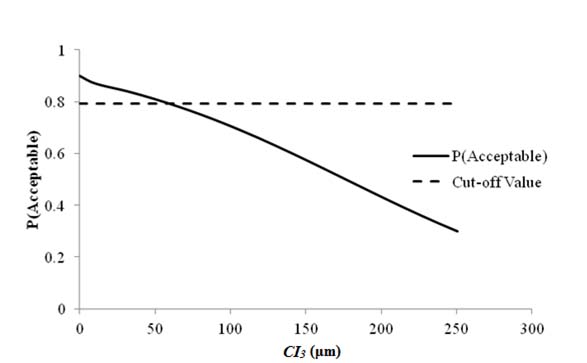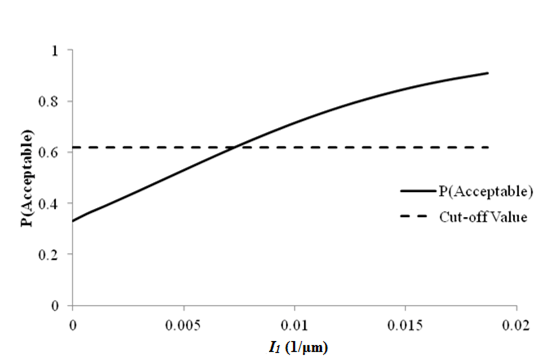U.S. Department of Transportation
Federal Highway Administration
1200 New Jersey Avenue, SE
Washington, DC 20590
202-366-4000
Federal Highway Administration Research and Technology
Coordinating, Developing, and Delivering Highway Transportation Innovations
| REPORT |
| This report is an archived publication and may contain dated technical, contact, and link information |
|
| Publication Number: FHWA-HRT-12-023 Date: December 2012 |
Publication Number: FHWA-HRT-12-023 Date: December 2012 |
Models Based on Rutting Performance for Flexible Pavements

1 μm = 0.039 mil
Figure 67. Graph. Sensitivity of rutting acceptable probability to deflection parameter CI3 for flexible pavements.

1 μm = 0.039 mil
Figure 68. Graph. Sensitivity of rutting acceptable probability to deflection parameter D1 for flexible pavements.

1 MPa = 145.03377 psi
Figure 69. Graph. Sensitivity of rutting acceptable probability to deflection parameter Hogg for flexible pavements
Models Based on Fatigue Cracking Performance for Flexible Pavements

1 1/ μm =25.4 1/mil
Figure 70. Graph. Sensitivity of fatigue cracking acceptable probability to deflection parameter I1 for flexible pavements.

1 MPa = 145.0377 psi
Figure 71. Graph. Sensitivity of fatigue cracking acceptable probability to deflection parameter Hogg for flexible pavements.
Models Based on Roughness Performance for Rigid Pavements (9,000 lb (4,086 kg))

1 μm = 0.039 mil
Figure 72. Graph. Sensitivity of roughness acceptable probability to deflection parameter CIf5 for rigid pavements (9,000 lb (4,086 kg)).

1 1/μm = 25.4 1/mil
Figure 73. Graph. Sensitivity of roughness acceptable probability to deflection parameter I1 for rigid pavements (9,000 lb (4,086 kg)).

Figure 74. Graph. Sensitivity of roughness acceptable probability to deflection parameter LTEA for rigid pavements (9,000 lb (4,086 kg)).
Models Based on Faulting at Joints Performance for Rigid Pavements (9,000 lb (4,086 kg))

1 μm = 0.039 mil
Figure 75. Graph. Sensitivity of faulting at joints acceptable probability to deflection parameter D6 for rigid pavements (9,000 lb (4,086 kg)).

Figure 76. Graph. Sensitivity of faulting at joints acceptable probability to deflection parameter LTEA for rigid pavements (9,000 lb (4,086 kg)).
Models Based on Transverse Cracking Performance for Rigid Pavements (9,000 lb (4,086 kg))

1 μm = 0.039 mil
Figure 77. Graph. Sensitivity of transverse cracking acceptable probability to deflection parameter CI4 for rigid pavements (9,000 lb (4,086 kg)).

1 μm = 0.039 mil
Figure 78. Graph. Sensitivity of transverse cracking acceptable probability to deflection parameter D1 for rigid pavements (9,000 lb (4,086 kg)).

Figure 79. Graph. Sensitivity of transverse cracking acceptable probability to deflection parameter LTEA for rigid pavements (9,000 lb (4,086 kg)).
Models Based on Roughness Performance for Rigid Pavements (12,000 lb (5,445 kg))

1 μm = 0.039 mil
Figure 80. Graph. Sensitivity of roughness acceptable probability to deflection parameter CI4 for rigid pavements (12,000 lb (5,445 kg)).

1 1/μm = 25.4 1/mil
Figure 81. Graph. Sensitivity of roughness acceptable probability to deflection parameter I1 for rigid pavements (12,000 lb (5,445 kg)).

Figure 82. Graph. Sensitivity of roughness acceptable probability to deflection parameter LTEA for rigid pavements (12,000 lb (5,445 kg)).
Models Based on Faulting at Joints Performance for Rigid Pavements (12,000 lb (5,445 kg))

1 μm = 0.039 mil
Figure 83. Graph. Sensitivity of faulting at joints acceptable probability to deflection parameter D6 for rigid pavements (12,000 lb (5,445 kg)).

Figure 84. Graph. Sensitivity of faulting at joints acceptable probability to deflection parameter LTEA for rigid pavements (12,000 lb (5,445 kg)).
Models Based on Transverse Cracking Performance for Rigid Pavements(12,000 lb (5,445 kg))

1 μm = 0.039 mil
Figure 85. Graph. Sensitivity of transverse cracking acceptable probability to deflection parameter CI4 for rigid pavements (12,000 lb (5,445 kg)).

1 μm = 0.039 mil
Figure 86. Graph. Sensitivity of transverse cracking acceptable probability to deflection parameter D1 for rigid pavements (12,000 lb (5,445 kg)).

Figure 87. Graph. Sensitivity of transverse cracking acceptable probability to deflection parameter LTEA for rigid pavements (12,000 lb (5,445 kg)).